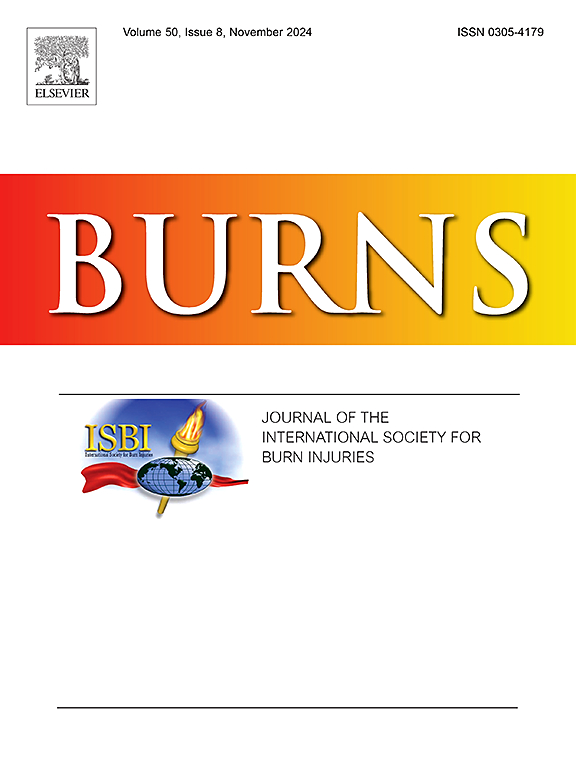Admission lymphopenia predicts risk of pneumonia and AKI in hospitalized burn injuries
IF 2.9
3区 医学
Q2 CRITICAL CARE MEDICINE
引用次数: 0
Abstract
Burn patients are at high risk for infectious complications due to immune dysregulation. This study investigated the relationship between admission lymphopenia (absolute lymphocyte count [ALC] < 1000) and burn injury outcomes. We hypothesized that lymphopenia would be associated with poor outcomes. This is a retrospective cohort study of all adult patients admitted from January 2017 to March 2023 for burn and/or inhalation injuries. Patients who died within 24 h were excluded. Demographics, comorbidities, ALC on admission, frailty status, admission and injury details including total burn surface area (TBSA), 2nd and 3rd degree TBSA, immunodeficient state, hospital course, surgical interventions, burn-specific and non-burn-specific complications, in-hospital mortality, and discharge disposition were collected. Univariate and multivariate analyses were performed to identify variables, including lymphopenia, associated with outcomes. P < 0.05 was considered significant. Of 286 eligible patients, 62 (21.7 %) were lymphopenic on admission. The cohort was predominantly male and white. Lymphopenic patients were older (64.5 y vs. 48 y, p < 0.001) and more likely to be frail (21 % vs. 4 %, p < 0.001). Immune-insufficient state, injury characteristics, hospital length of stay (LOS), LOS/TBSA, ventilator days, skin graft requirements, or in-hospital mortality were not significantly different between the groups. Adjusting for age, gender, frailty, inhalation injury, comorbidities, and %TBSA, lymphopenia was associated with increased risks of developing pneumonia (OR = 4.28 [1.19–15.47], p = 0.026) and AKI (3.90 [1.41–10.77], p = 0.009). Early identification of patients with higher risk for complications is imperative in burn management.
入院淋巴细胞减少可预测住院烧伤患者肺炎和AKI的风险
由于免疫失调,烧伤患者感染并发症的风险很高。本研究探讨了入院淋巴细胞减少(绝对淋巴细胞计数[ALC] <;1000)和烧伤结果。我们假设淋巴细胞减少与不良预后有关。这是一项回顾性队列研究,纳入了2017年1月至2023年3月因烧伤和/或吸入性损伤入院的所有成年患者。排除在24 h内死亡的患者。统计资料、合并症、入院时ALC、虚弱状态、入院和损伤细节,包括总烧伤表面积(TBSA)、二度和三度TBSA、免疫缺陷状态、住院过程、手术干预、烧伤特异性和非烧伤特异性并发症、住院死亡率和出院处置。进行单因素和多因素分析以确定与结果相关的变量,包括淋巴细胞减少。P <; 0.05被认为是显著的。在286例符合条件的患者中,62例(21.7% %)入院时淋巴细胞减少。研究对象主要是男性和白人。淋巴细胞减少的患者年龄较大(64.5 y对48 y, p <; 0.001),更容易虚弱(21 %对4 %,p <; 0.001)。免疫不足状态、损伤特征、住院时间(LOS)、LOS/TBSA、呼吸机天数、皮肤移植需求或住院死亡率在两组间无显著差异。调整年龄、性别、虚弱、吸入性损伤、合并症和TBSA百分比后,淋巴细胞减少与发生肺炎(OR = 4.28 [1.19-15.47], p = 0.026)和AKI (3.90 [1.41-10.77], p = 0.009)的风险增加相关。在烧伤管理中,早期识别并发症风险较高的患者是必要的。
本文章由计算机程序翻译,如有差异,请以英文原文为准。
求助全文
约1分钟内获得全文
求助全文
来源期刊

Burns
医学-皮肤病学
CiteScore
4.50
自引率
18.50%
发文量
304
审稿时长
72 days
期刊介绍:
Burns aims to foster the exchange of information among all engaged in preventing and treating the effects of burns. The journal focuses on clinical, scientific and social aspects of these injuries and covers the prevention of the injury, the epidemiology of such injuries and all aspects of treatment including development of new techniques and technologies and verification of existing ones. Regular features include clinical and scientific papers, state of the art reviews and descriptions of burn-care in practice.
Topics covered by Burns include: the effects of smoke on man and animals, their tissues and cells; the responses to and treatment of patients and animals with chemical injuries to the skin; the biological and clinical effects of cold injuries; surgical techniques which are, or may be relevant to the treatment of burned patients during the acute or reconstructive phase following injury; well controlled laboratory studies of the effectiveness of anti-microbial agents on infection and new materials on scarring and healing; inflammatory responses to injury, effectiveness of related agents and other compounds used to modify the physiological and cellular responses to the injury; experimental studies of burns and the outcome of burn wound healing; regenerative medicine concerning the skin.
 求助内容:
求助内容: 应助结果提醒方式:
应助结果提醒方式:


